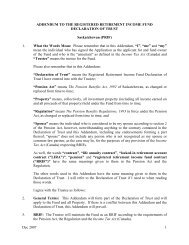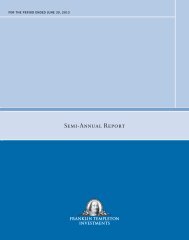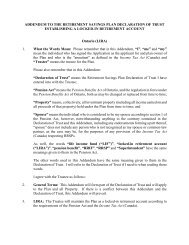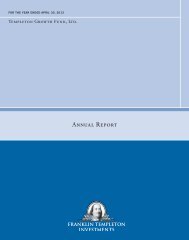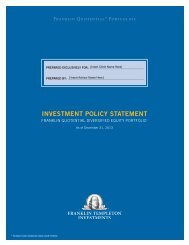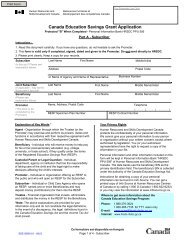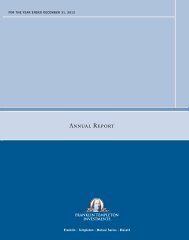OverviewWe are a global investment management company and derive substantially all of our operatingrevenues and net income from providing investment management and related services to our retail andinstitutional mutual funds, unregistered funds, and to institutional, high net-worth and separately-managedaccounts and other investment products. Our services include fund administration, shareholder services,transfer agency, underwriting, distribution, custodial, trustee and other fiduciary services. Our sponsoredinvestment products and investment management and related services are distributed or marketed to thepublic globally under six distinct brand names: Franklin, Templeton, Mutual Series, Bissett, Fiduciary Trustand Darby.We offer a broad range of sponsored investment products under equity, hybrid, fixed-income and cashmanagement categories that meet a wide variety of specific investment needs of individual and institutionalinvestors. Cash management consists of U.S.-registered money market funds and non-U.S.-registered funds(“Non-U.S. Funds”) with similar investment objectives.The level of our revenues depends largely on the level and relative mix of assets under management.As noted in the “Risk Factors” section set forth above in Item 1A of this Annual Report on Form 10-K, theamount and mix of our assets under management are subject to significant fluctuations and can negativelyimpact our revenues and income. To a lesser degree, the level of our revenues also depends on the level ofmutual fund sales and the number of mutual fund shareholder accounts. The fees charged for our servicesare based on contracts with our sponsored investment products or our clients. These arrangements couldchange in the future.Our secondary business is banking/finance. Our banking/finance group offers retail banking andconsumer lending services and private banking services to high net-worth clients. Our consumer lendingand retail banking activities include consumer credit and debit cards, real estate equity lines, home equity/mortgage lending, and automobile lending related to the purchase, securitization, and servicing of retailinstallment sales contracts originated by independent automobile dealerships.During the fiscal year ended September 30, 2009 (“fiscal year 2009”), the global financial crisis thatbegan in 2008 continued and the economy remained in a recession. The turmoil in the global financialmarkets during the first half of the fiscal year, evidenced by 31% decreases in both the MSCI World andS&P 500 indexes, negatively impacted the entire asset management industry. The unprecedented downturnin the markets significantly affected our assets under management, fee revenues and non-operating income,all of which decreased sharply during the fiscal year.Governments and central banks around the world focused on increasing liquidity in the capital marketsand easing the financial crisis. Credit conditions began to improve during the second half of the fiscal year,as credit availability increased and credit spreads tightened. Improvement in market conditions was alsoindicated by increases of 42% and 34% in the MSCI World and S&P 500 indexes during the second half.Our results of operations improved during our third and fourth fiscal quarters consistent with the positivemarket performance.Our total assets under management at September 30, 2009 were $523.4 billion, 3% higher than theywere at September 30, 2008. However, simple monthly average assets under management for the twelvemonths ended September 30, 2009 decreased 27% from the prior fiscal year due to significantly lowerlevels of assets under management during the first half of the fiscal year. Total assets under managementwere negatively impacted by market depreciation of $90.0 billion during the first half of the fiscal year andthen benefited from market appreciation of $115.4 billion during the second half. Net new flows were anegative $23.7 billion during the first half of the fiscal year as investor demand shifted to lower risk38
investments, and swung to a positive $18.2 billion in the second half as long-term sales increased, mostnotably in our fixed-income funds. Overall, we had negative net new flows of $5.5 billion for the fiscalyear.During fiscal year 2009, we took steps to manage our business and our cost structure to respond to themarket conditions and resulting decrease in revenue, including reducing expenditures in areas such as traveland entertainment, advertising, and contractor and professional fees, and deferring non-business criticalinitiatives and hiring. We also announced reductions to our global workforce of approximately 10%. Theseverance costs related to these workforce reductions amounted to $38.4 million for the fiscal year. Wecontinue to assess cost reduction measures as we adapt to the unprecedented changes affecting our industry.Despite the ongoing financial crisis, the relative performance of our sponsored investment productsremained strong, with 85% to 90% of our U.S.-registered long-term mutual funds in the top half of theLipper performance rankings as both equity and fixed-income funds showed significant improvement infiscal year 2009.Challenging and volatile market conditions might continue to be present in the foreseeable future. Aswe confront the challenges of this economic environment, we expect to continue to focus on the investmentperformance of our sponsored investment products and on providing high quality customer service to ourclients. While we are focused on reducing costs, we will also seek to attract, retain and develop employeesand invest strategically in systems and technology that will provide secure, stable environments andeconomies of scale. We will also seek to continue to protect and further our brand recognition whiledeveloping and maintaining broker/dealer and client relationships. The success of these and other strategiesmay be influenced by the factors discussed in Item 1A Risk Factors of this Annual Report, and other factorsas discussed herein.Results of Operations(dollar amounts in millions, except per share data)for the fiscal years ended September 30, 2009 2008 20072009vs. 20082008vs. 2007Operating Income .............................. $1,202.6 $2,099.0 $2,067.5 (43)% 2%Net Income .................................... 896.8 1,588.2 1,772.9 (44)% (10)%Earnings Per ShareBasic ..................................... $ 3.89 $ 6.72 $ 7.11 (42)% (5)%Diluted .................................... 3.87 6.67 7.03 (42)% (5)%Operating Margin 1 ............................. 29% 35% 33%1 Defined as operating income divided by total operating revenues.Net income decreased in fiscal year 2009 primarily due to an $896.4 million decline in operatingincome. Adverse market conditions led to a 27% decrease in our simple monthly average assets undermanagement, which resulted in a 30% decrease in our operating revenues. As described above, we havetaken actions to reduce our operating expenses in response to the market conditions and resulting revenuedecreases, which contributed to a 24% decrease in operating expenses for the fiscal year.Operating income increased in the fiscal year ended September 30, 2008 (“fiscal year 2008”),consistent with a 3% decrease in operating revenues and a 5% decrease in operating expenses. Operatingrevenues remained stable despite the sustained volatility experienced in the financial markets as we beganthe year with a high level of assets under management. We also benefited from the diversification of ourproducts and customer base and successful marketing campaigns. During fiscal year 2008 we initiated stepsto manage our business and our cost structure in response to the deteriorating market conditions.39
- Page 1 and 2: G A I N F R O M O U R P E R S P E C
- Page 3 and 4: Letter to StockholdersGregory E. Jo
- Page 5 and 6: LETTER TO STOCKHOLDERSHaving announ
- Page 7 and 8: Directors and OfficersDirectorsChar
- Page 9 and 10: Performance GraphThe following perf
- Page 11 and 12: (MARK ONE)UNITED STATESSECURITIES A
- Page 14 and 15: operational and other services requ
- Page 16 and 17: A. Assets Under Management (“AUM
- Page 18 and 19: 60 days. If agreements representing
- Page 20 and 21: Similar arrangements exist with the
- Page 22 and 23: We generally operate our institutio
- Page 24 and 25: Franklin Templeton Variable Insuran
- Page 26 and 27: CATEGORY(and approximate amount of
- Page 28 and 29: The following table sets forth the
- Page 30 and 31: Korea; the Commission de Surveillan
- Page 32 and 33: COMPETITIONThe financial services i
- Page 34 and 35: or other efforts successfully stabi
- Page 36 and 37: and, consequently, we are incurring
- Page 38 and 39: such as information, systems and te
- Page 40 and 41: like our business, is based in part
- Page 42 and 43: orrowing costs and limit our access
- Page 44 and 45: director of various subsidiaries of
- Page 46 and 47: PART IIItem 5. Market for Registran
- Page 50 and 51: Net income decreased in fiscal year
- Page 52 and 53: Investment Management Fee RateThe f
- Page 54 and 55: accounts closed in a calendar year
- Page 56 and 57: Information Systems, Technology and
- Page 58 and 59: Our investments in sponsored invest
- Page 60 and 61: At September 30, 2009, we had $355.
- Page 62 and 63: Off-Balance Sheet ArrangementsAs of
- Page 64 and 65: The fair value of retained subordin
- Page 66 and 67: Indefinite-lived intangible assets
- Page 68 and 69: the position will be sustained upon
- Page 70 and 71: Selected Quarterly Financial Data (
- Page 72 and 73: The following is a summary of the e
- Page 74 and 75: Item 8.Financial Statements and Sup
- Page 76 and 77: REPORT OF INDEPENDENT REGISTERED PU
- Page 78 and 79: CONSOLIDATED BALANCE SHEETS(dollars
- Page 80 and 81: CONSOLIDATED STATEMENTS OF STOCKHOL
- Page 82 and 83: CONSOLIDATED STATEMENTS OF CASH FLO
- Page 84 and 85: Fair Value Measurements. The Compan
- Page 86 and 87: Company held interest-rate swap agr
- Page 88 and 89: not performed. If the carrying valu
- Page 90 and 91: Accumulated Other Comprehensive Inc
- Page 92 and 93: acquisition cost was allocated to t
- Page 94 and 95: FHLB borrowings and amounts availab
- Page 96 and 97: The Company recognized other-than-t
- Page 98 and 99:
The changes in Level 3 assets measu
- Page 100 and 101:
Changes in the allowance for loan l
- Page 102 and 103:
Company sold retained subordinated
- Page 104 and 105:
Certain of the goodwill and intangi
- Page 106 and 107:
At September 30, 2009, maturities o
- Page 108 and 109:
The components of the net deferred
- Page 110 and 111:
At September 30, 2009, the banking/
- Page 112 and 113:
Total assets under management of in
- Page 114 and 115:
Stock OptionsThe following table su
- Page 116 and 117:
The following tables summarize info
- Page 118 and 119:
Operating revenues of the banking/f
- Page 120 and 121:
minimum Tier 1 and Total risk-based
- Page 122 and 123:
PART IIIItem 10. Directors, Executi
- Page 124 and 125:
Item 15.(a)(1)(a)(2)(a)(3)PART IVEx
- Page 126 and 127:
Exhibit No.Description10.17 Represe
- Page 128 and 129:
Exhibit No.Description12 Computatio
- Page 130 and 131:
Exhibit No.DescriptionEXHIBIT INDEX
- Page 132 and 133:
Exhibit No.Description10.22 Amendme
- Page 134 and 135:
(dollars in thousands)COMPUTATION O
- Page 136 and 137:
NameState or Nation ofIncorporation
- Page 138 and 139:
CONSENT OF INDEPENDENT REGISTERED P
- Page 140 and 141:
EXHIBIT 31.2CERTIFICATIONI, Kenneth
- Page 142 and 143:
CERTIFICATION PURSUANT TO 18 U.S.C.
- Page 144:
One Franklin ParkwaySan Mateo, CA 9



